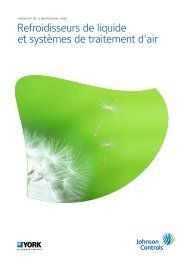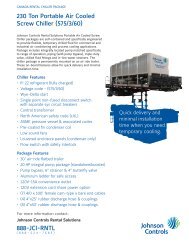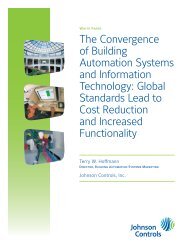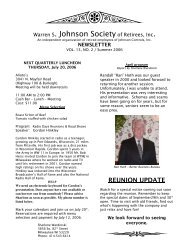Rxf - Johnson Controls Inc.
Rxf - Johnson Controls Inc.
Rxf - Johnson Controls Inc.
Create successful ePaper yourself
Turn your PDF publications into a flip-book with our unique Google optimized e-Paper software.
THERMOSYPHON OIL COOLING<br />
Thermosyphon oil cooling is an economical, effective method<br />
for cooling oil on screw com pressor units. Thermo syphon<br />
cooling utilizes liquid refrigerant at condenser pressure and<br />
temperature which is partially vaporized at the condenser<br />
temperature in a shell and tube or plate-type vessel, cooling<br />
the oil. The vapor, at condensing pressure, is vented to the<br />
condenser inlet and reliquified. This method is the most cost<br />
effective of all currently applied cooling systems since no<br />
compressor capacity loss or compressor power penalties are<br />
incurred. The vapor from the cooler need only be con densed,<br />
not compressed. Refrigerant flow to the cooler is automatic,<br />
driven by the thermosyphon principle, and cooling flow<br />
increases as the oil inlet tempera ture rises.<br />
Figure 28<br />
SYSTEM OPERATION: Liquid refrigerant fills the cooler.<br />
Warm or hot oil (above the liquid return temperature) flowing<br />
through the cooler will cause some of the refrigerant to boil<br />
and vaporize. The vapor rises in the return line.<br />
The density of the refrigerant liquid/vapor mixture in the<br />
return line is considerably less than the density of the liquid<br />
in the supply line. This imbalance provides a dif ferential<br />
pressure which sustains a flow condition to the oil cooler.<br />
This relationship inv olves:<br />
1. Liquid height above the cooler.<br />
2. Oil heat of rejection.<br />
3. Cooler size and piping pressure drops.<br />
Current thermosyphon systems are using single-pass oil<br />
coolers and flow rates based on 3:1 overfeed.<br />
The liquid/vapor returned from the cooler is separated in<br />
the receiver. The vapor is vented to the condenser inlet and<br />
need only be reliquified since it is still at condenser pres sure<br />
(see Figure 28).<br />
RXF ROTARY SCREW COMPRESSOR UNITS<br />
OPERATION<br />
070.410-IOM (JUL 11)<br />
Page 21<br />
INITIAL START-UP PROCEDURE<br />
Having performed the checkpoints on the Prestart Checklist<br />
(see FORMS in Table of Contents), the compressor unit is<br />
ready for start-up. It is important that an adequate refrigerant<br />
load be available to load test the unit at normal operating<br />
conditions. The following points should be kept in mind during<br />
initial start-up.<br />
1. On start-up the unit should be operated at as high a load<br />
possible for 3 hours. During the period, adjust liquid injection<br />
oil cooling, if applicable. If unit has water-cooled oil cooling,<br />
adjust water control valve to cooler (if applicable).<br />
2. The compressor slide valve should be calibrated.<br />
3. Pull and clean suction strainer after 24 hours operation. If<br />
it is excessively dirty, repeat every 24 hours until system is<br />
clean. Otherwise, follow the Maintenance Schedule. See the<br />
Recommended Maintenance Program section.<br />
NORMAL START-UP PROCEDURE<br />
1. Confirm system conditions permit starting the compressor.<br />
2. Press the [RUN] key.<br />
3. Allow the compressor to start up and stabilize. At startup,<br />
the slide stop (volumizer) and the slide valve (capacity<br />
control) are in the AUTO mode.<br />
RESTARTING COMPRESSOR UNIT AFTER<br />
CONTROL POWER INTERRUPTION<br />
(PLANT POWER FAILURE)<br />
1. Check ADJUSTABLE setpoints.<br />
2. Follow normal start-up procedure.










![[PDF] Intelligent Fire Annunciator IFA-1000 - Johnson Controls Inc.](https://img.yumpu.com/7424420/1/190x245/pdf-intelligent-fire-annunciator-ifa-1000-johnson-controls-inc.jpg?quality=85)





